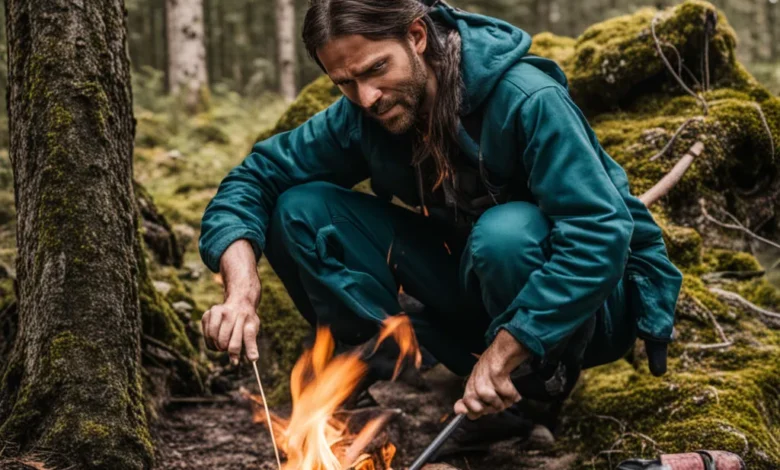Boost Confidence with Outdoor Survival Skills | Self-Growth

Introduction
Have you ever wondered how learning to start a fire or build a shelter could boost your self-esteem? Welcome to the world of outdoor survival skills – a gateway to personal growth and confidence that extends far beyond the wilderness.
In recent years, there’s been a growing interest in outdoor activities and self-reliance. More people are discovering that mastering survival techniques not only prepares them for adventures but also enhances their everyday lives.
This article will explore how acquiring these skills can significantly impact your personal confidence and overall well-being. Whether you’re an outdoor enthusiast or simply curious about self-improvement, you’ll find valuable insights here.
What Are Outdoor Survival Skills?
Outdoor survival skills are techniques that help you stay alive and thrive in nature, especially in challenging or emergency situations. These skills go beyond basic camping knowledge, preparing you for unexpected scenarios in the wild.
Here’s a list of essential outdoor survival skills:
- Fire-starting: Creating and maintaining a fire for warmth, cooking, and signaling
- Shelter building: Constructing temporary refuge from the elements
- Water sourcing and purification: Finding and making water safe to drink
- Navigation: Using maps, compasses, and natural indicators to find your way
- Foraging and food procurement: Identifying edible plants and catching food
- First aid and emergency response: Handling injuries and medical situations in remote areas
Learning these skills doesn’t just prepare you for outdoor emergencies. It also builds self-reliance and problem-solving abilities that carry over into everyday life.
The Connection Between Survival Skills and Confidence
You might wonder, “How does learning to purify water or build a shelter make me more confident?” The answer lies in the sense of competence and self-efficacy that comes from mastering these skills.
When you know you can handle challenging situations, your overall confidence grows. This isn’t just anecdotal – psychological studies support this connection. Research shows that acquiring new skills, especially those that foster independence, can significantly boost self-esteem.
For example, a study published in the Journal of Experiential Education found that wilderness education programs led to increased self-confidence and improved self-perception among participants. This suggests that learning outdoor survival skills can have a profound impact on personal growth.
Key Benefits of Learning Outdoor Survival Skills
Learning outdoor survival skills offers numerous advantages that extend far beyond the wilderness. Let’s explore how these skills can positively impact various aspects of your life.
Increased Self-Reliance
One of the most significant benefits of mastering outdoor survival skills is the boost in self-reliance. When you know you can:
- Start a fire in challenging conditions
- Find and purify water
- Build a shelter from natural materials
- Navigate without modern technology
You develop a profound sense of independence. This self-reliance isn’t limited to outdoor scenarios – it translates into everyday life, making you more confident in handling various challenges.
For example, someone who has learned to problem-solve in nature might approach a work crisis with more calm and creativity. The ability to rely on yourself in tough situations is a powerful confidence booster.
Enhanced Problem-Solving Abilities
Survival scenarios in nature are essentially complex puzzles that require creative solutions. As you learn and practice outdoor skills, you’re constantly exercising your critical thinking and adaptability.
Here are some ways survival skills improve problem-solving:
- Quick decision-making under pressure
- Resourcefulness with limited materials
- Adapting plans to changing conditions
- Thinking outside the box for unconventional solutions
These enhanced problem-solving skills become valuable assets in your personal and professional life, contributing to increased confidence in your abilities.
Improved Physical Fitness
Learning and practicing outdoor survival skills often involves physical activity, which contributes to overall health and fitness. This physical component has several benefits:
| Physical Benefit | How It Boosts Confidence |
|---|---|
| Increased strength | Feeling more capable in daily tasks |
| Improved endurance | Greater stamina for life’s challenges |
| Better balance and coordination | Enhanced body awareness and control |
| Weight management | Improved self-image and health |
As your physical fitness improves through outdoor activities, you’ll likely notice a corresponding increase in your self-confidence and body image.
Stress Reduction and Mental Well-being
Engaging with nature and learning survival skills can significantly reduce stress and improve mental health. Studies have shown that spending time outdoors and engaging in nature-based activities can:
- Lower cortisol levels (the stress hormone)
- Reduce symptoms of anxiety and depression
- Improve mood and overall well-being
- Enhance cognitive function and creativity
For instance, a study published in the International Journal of Environmental Research and Public Health found that forest bathing (spending time in nature) led to decreased stress levels and improved mental health.
By providing a break from daily pressures and fostering a sense of accomplishment, outdoor survival skills contribute to better mental health and, consequently, increased confidence.
Better Appreciation for Nature
As you spend more time outdoors and learn to work with the environment, you develop a deeper connection with nature. This appreciation often leads to:
- Increased environmental awareness
- A sense of belonging in the natural world
- Greater understanding of ecological systems
- Motivation for conservation efforts
This connection to nature can provide a sense of purpose and perspective, further enhancing your overall confidence and well-being.
How Learning Survival Skills Translates to Everyday Life
The benefits of outdoor survival skills extend far beyond the wilderness, positively impacting various aspects of your daily life.
Improved Decision-Making in Daily Situations
Learning to make quick, informed decisions in survival scenarios sharpens your decision-making skills overall. This improved ability can help you:
- Navigate workplace challenges more effectively
- Make better personal choices
- Respond calmly to unexpected situations at home or work
For example, someone who’s learned to assess risks in the wild might be better equipped to evaluate business opportunities or personal investments.
Enhanced Ability to Handle Unexpected Challenges
Life is full of surprises, and survival skills prepare you to adapt. The problem-solving mindset you develop can help you:
- Stay calm during crises
- Think creatively when faced with obstacles
- Approach challenges as opportunities for growth
Whether it’s a sudden job loss, a home repair emergency, or a family crisis, your enhanced adaptability can help you navigate these situations with greater confidence.
Increased Overall Resilience and Adaptability
Resilience – the ability to bounce back from setbacks – is a crucial life skill. Outdoor survival training builds this resilience by:
- Teaching you to persist in difficult conditions
- Helping you learn from failures and setbacks
- Building mental toughness
This increased resilience can help you maintain confidence even when facing life’s inevitable ups and downs.
Getting Started with Outdoor Survival Skills
If you’re inspired to boost your confidence through learning outdoor survival skills, here are some beginner-friendly ways to get started:
- Online courses and tutorials: Many platforms offer comprehensive courses on wilderness survival.
- Local wilderness schools and workshops: Hands-on learning experiences with expert instructors.
- Books and guides on outdoor survival: Great for in-depth knowledge and reference.
- Joining outdoor clubs or groups: Learn from experienced members and practice in a supportive environment.
Safety Considerations and Precautions
While learning outdoor survival skills can be exciting, it’s crucial to prioritize safety:
- Start with basic skills in controlled environments before attempting advanced techniques.
- Always inform someone of your plans when heading outdoors.
- Carry essential safety gear, including a first-aid kit and communication device.
- Know your limits and don’t take unnecessary risks.
- Consider taking a wilderness first aid course to complement your survival skills.
Remember, the goal is to build confidence, not to put yourself in dangerous situations unnecessarily.
Personal Stories and Testimonials
To illustrate the real-world impact of learning outdoor survival skills, let’s look at a couple of brief anecdotes:
Sarah, a 32-year-old office worker, shares: “After taking a wilderness survival course, I noticed a significant change in how I approached problems at work. I felt more confident in my ability to find solutions, even in high-pressure situations.”
Mark, a 45-year-old teacher, explains: “Learning survival skills helped me overcome my fear of public speaking. If I could start a fire in the rain, I figured I could handle a classroom full of students!”
These stories highlight how the confidence gained from outdoor skills can positively impact various aspects of life, from career challenges to personal growth.
Conclusion
Learning outdoor survival skills offers far more than just preparation for wilderness adventures. As we’ve explored throughout this article, these skills can significantly boost your personal confidence and enhance various aspects of your daily life.
Let’s recap the main benefits of mastering outdoor survival skills:
- Increased self-reliance: You’ll develop a strong sense of independence that carries over into everyday situations.
- Enhanced problem-solving abilities: The challenges of survival scenarios sharpen your critical thinking skills.
- Improved physical fitness: Outdoor activities contribute to better overall health and body confidence.
- Stress reduction and mental well-being: Connecting with nature and mastering new skills can significantly improve your mental health.
- Better appreciation for nature: You’ll gain a deeper understanding of the environment and your place within it.
- Improved decision-making: The skills you learn will help you make better choices in all areas of life.
- Increased resilience and adaptability: You’ll be better equipped to handle unexpected challenges and setbacks.
These benefits combine to create a powerful boost to your self-confidence, impacting everything from your career to your personal relationships.
Whether you’re an outdoor enthusiast looking to take your skills to the next level, or someone who’s never spent a night under the stars, learning outdoor survival skills can be a transformative experience. It’s not just about being prepared for emergencies – it’s about discovering your own strength, resilience, and capability.
We encourage you to take the first step in exploring these skills. Start small – perhaps with a basic fire-starting course or a guided nature walk. As you build your knowledge and experience, you’ll likely find that your confidence grows not just in outdoor settings, but in all areas of your life.
Remember, the journey of learning outdoor survival skills is ongoing. Each new skill you master is another building block in your confidence and self-reliance. Embrace the challenges, celebrate your successes, and don’t be afraid to step out of your comfort zone.
By investing time in learning these valuable skills, you’re not just preparing for outdoor adventures – you’re equipping yourself with the confidence and capability to thrive in all aspects of life. So why wait? Take that first step today and start your journey towards greater self-reliance and personal confidence.
Your future, more confident self will thank you for the adventure you’re about to embark upon. Happy exploring!



